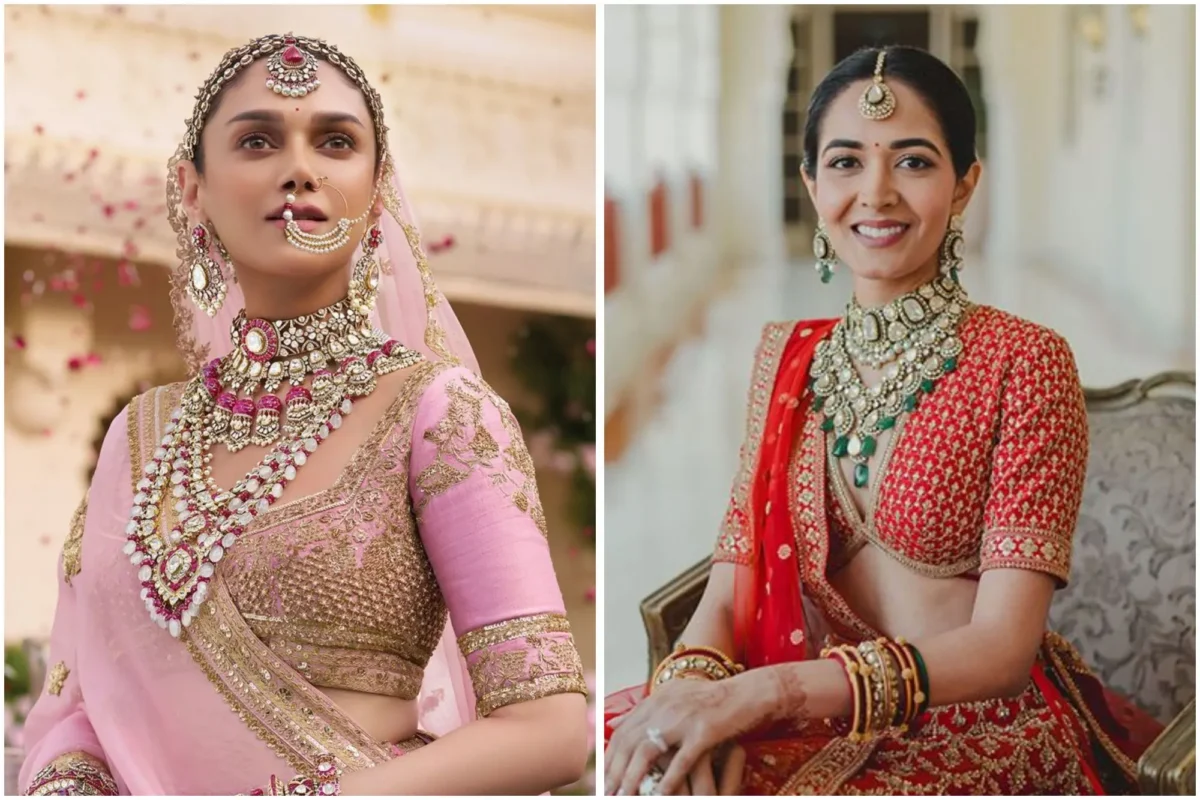From opulent North to traditional South, the bridal jewellery styles in every region of India are unique and elegant in their own right.
In India, bridal jewellery is far more than just adornment; it’s an heirloom, a symbol of heritage, and an integral part of the bridal identity. Across the country’s diverse states, each region carries its own distinct jewellery traditions, shaped by history, craftsmanship, and cultural significance. From intricate temple motifs in the South to the regal polki sets of the North, every piece tells a story of lineage, artistry and regional pride.
Here is Team Wedding Affair taking you through the map of India, one jewel at a time. Keep reading to learn more.
North India – Opulence in Polki and Kundan

When you think of North Indian bridal jewellery, grandeur takes centre stage. Rajasthan and Uttar Pradesh, in particular, are celebrated for Kundan and Polki jewellery styles that originated in the Mughal era.
Kundan is crafted by setting uncut glass stones in gold; it’s known for its flat, radiant surface and elaborate patterns. Similar to Kundan, Polki uses uncut natural diamonds, giving a more raw and antique appeal.
A North Indian bride often wears heavy chandbalis, maang tikka, nath (nose ring), and a rani haar (long necklace) layered over a choker. The regal touch is completed with bajuband (armlets) and haath phool (hand harnesses). The overall look reflects royalty and tradition, perfect for the grand palatial weddings the region is known for.
Read Also: The Right Bridal Jewellery Style for Each Event
West Bengal – The Golden Adornment
For Bengali brides, bridal jewellery is steeped in symbolism. Crafted almost entirely in gold, the designs are ornate yet fluid, blending folk motifs with delicate filigree work.
Key pieces include Tikli (Bengali-style maang tikka), Paati Haar (a wide choker with intricate floral or paisley patterns), Sita Haar (a long, multi-layered necklace for elegance) and Jhumko (bell-shaped earrings with tiny dangling details.)
Bengali bridal jewellery is often inspired by nature—sun, flowers, and leaves frequently appear in the motifs. The warm glow of gold complements the traditional red Banarasi saree, making the bride look timeless and luminous.
Maharashtra – The Beauty of Heritage Gold
A Maharashtrian bride’s jewellery is distinctive, with a mix of traditional Kolhapuri saaj and temple-inspired motifs.
Key bridal jewellery pieces include Mundavalya (A unique ornament of pearl strings worn across the forehead), Thushi (A choker made of closely strung gold beads, known for its flexible design), Kolhapuri Saaj (A necklace with 21 pendants, each with symbolic meaning—from protection against evil to blessings for fertility.) and Bugadi (Small, decorative ear ornaments worn on the helix.)
Green glass bangles are also essential, symbolising fertility and prosperity, often paired with solid gold kadas.
Punjab – The Bold and Beautiful Bride
Punjabi brides favour bold gold jewellery that reflects vibrance and abundance. A signature element is the Chooda—a set of red and ivory bangles, often paired with Kalire (dangling golden ornaments symbolising blessings).
Other must-haves include Matha Patti (a head ornament that frames the forehead elegantly), Rani Haar layered with chokers and heavy Jhumkas and naths with elaborate chains
Punjabi bridal jewellery is all about celebrating life with grandeur, often passed down as family treasures.
Read Also: The Ultimate Haathphool Design Guide Every Bride Needs
South India – Temple Gold Grandeur
In the South, bridal jewellery is deeply connected to divinity, with temple jewellery taking pride of place. Originating in Tamil Nadu and Karnataka, these designs are inspired by deities, temple architecture, and mythological motifs.
Signature pieces include Kasulaperu / Kasu Mala (A necklace made of gold coins), Vanki (An armlet shaped like a “V” with intricate carvings), Oddiyanam )A broad waist belt in gold, often studded with rubies and emeralds), and Jadanagam (Hair ornamentation in serpent-like patterns for braided hairstyles)
South Indian brides also wear layers of long harams with chokers, often crafted in antique gold finishes. The effect is rich, auspicious, and steeped in cultural pride.
Gujarat – Colourful and Statement-Making
Gujarati bridal jewellery often merges traditional gold with colourful meenakari (enamel work) and kundan techniques. Some key pieces are Matha Patti with floral designs, Hath Pan (hand harnesses) adorned with pearls and gemstones, Chandlo: A forehead ornament that sits higher than the maang tikka and Patla Bangles: Flat, broad bangles with intricate engravings
In Gujarati weddings, the bride’s jewellery is chosen to complement her richly embroidered Panetar or Gharchola saree, often using pops of red and green stones.
Kashmir – The Delicate Art of Dejhor
Kashmiri bridal jewellery stands apart with its refined, delicate aesthetic. The most iconic ornament is the Dejhor—long gold pendants suspended from the ears, traditionally worn by married women. Brides also wear athoor (floral headpieces) and finely worked gold necklaces. The jewellery often incorporates motifs from nature, such as the chinar leaf, symbolic of Kashmir’s cultural identity.
Odisha and Assam – Silver and Gold Harmony
In Odisha, silver jewellery holds a special place, especially for pre-wedding rituals, with gold taking prominence for the main ceremony. Designs often feature lotus, conch shells, and other sacred motifs.
In Assam, the Jun Biri necklace, crafted in gold with red enamel detailing, is a signature piece. Assamese brides prefer light yet ornate designs, which beautifully complement their traditional Mekhela Chador.
Read Also: Our Favourite Celebrity Jewellery Moments of 2025
These diverse regional bridal jewellery designs make India’s bridal jewellery heritage one of the richest and most diverse in the world.
Subscribe to Wedding Affair for more such content.